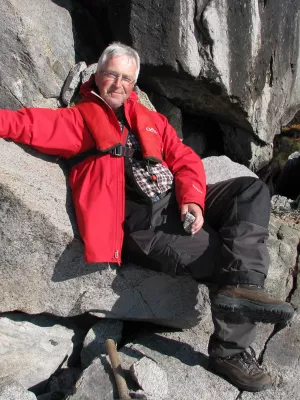
Leif Johansson
Professor emeritus

Elemental composition of ectomycorrhizal mycelia identified by PCR-RFLP analysis and grown in contact with apatite or wood ash in forest soil
Författare
Summary, in English
The aim of this study was to identify ectomycorrhizal species with a potential to release elements from apatite and wood ash and accumulate them in the mycelia. Fungal rhizomorphs and mycelia were sampled from sand-filled mesh bags with or without amendment of apatite or wood ash. The mesh bags were buried in forest soil in the field for 13 or 24 months. Elemental composition of the samples was analyzed with particle-induced X-ray emission and the fungus was identified by polymerase chain reaction-restriction fragment length polymorphism analysis of the ITS-region of ribosomal DNA. The majority of rhizomorphs and mycelia collected from the mesh bags were of mycorrhizal origin with Paxillus involutus being the most common species (31%). Other identified species were Thelephora terrestris, Suillus granulatus and Tylospora fibillosa. S. granulatus contained 3-15 times more K (3 mg g(-1)) than the other species and had large calcium-rich crystals deposited on the surface of rhizomorphs when grown in contact with apatite. P. involutus contained the largest amount of Ca (2-7 mg g(-1)). Wood ash addition increased the amount of Ti, Mn and Pb in the rhizomorphs while apatite addition increased the amount of Ca in the rhizomorphs. The high concentration of K in S. granulatus rhizomorphs suggests that this fungus is a good accumulator of K while P. involutus appeared to accumulate heavy metals originating from wood ash.
Avdelning/ar
- MEMEG
- Biologiska institutionen
- Geologiska institutionen
- Berggrundsgeologi
- Kärnfysik
- Mikrobiologisk ekologi
Publiceringsår
2003
Språk
Engelska
Sidor
57-65
Publikation/Tidskrift/Serie
FEMS Microbiology Ecology
Volym
44
Issue
1
Dokumenttyp
Artikel i tidskrift
Förlag
Oxford University Press
Ämne
- Subatomic Physics
- Geology
- Biological Sciences
Status
Published
Forskningsgrupp
- Nuclear Microprobe
- Microbial Ecology
ISBN/ISSN/Övrigt
- ISSN: 1574-6941

